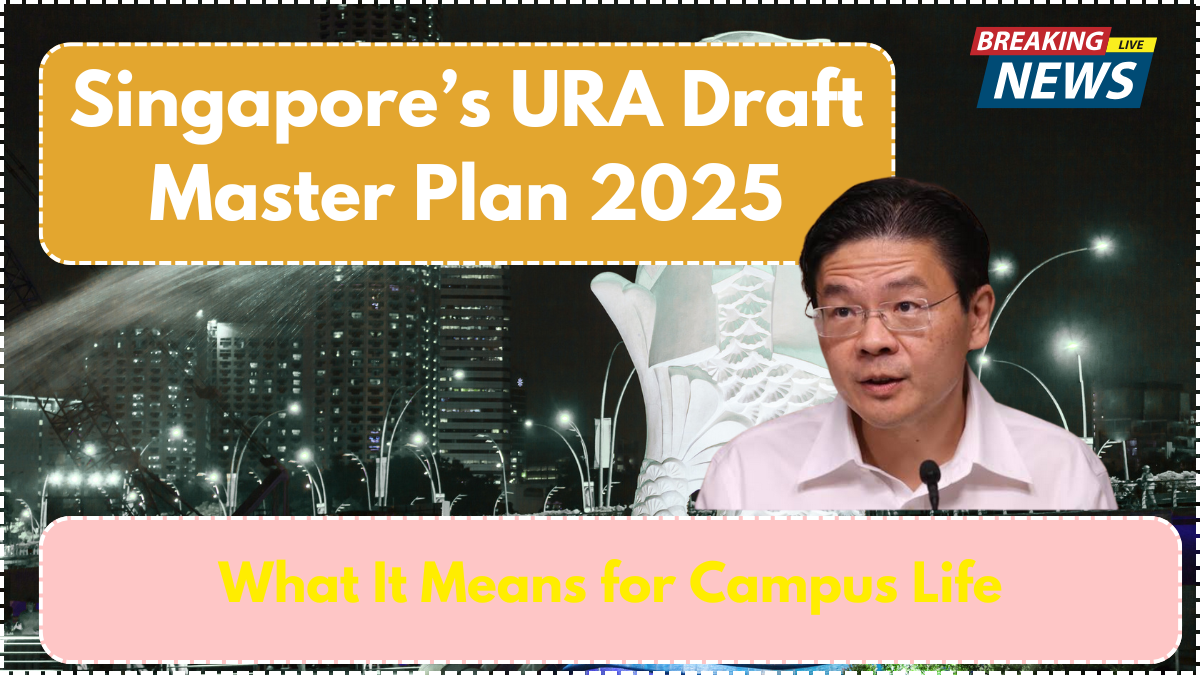Singapore’s Urban Redevelopment Authority (URA) has released the Draft Master Plan 2025, and it’s more than just a blueprint for infrastructure. This time, it’s a strategic framework that redefines how educational spaces integrate with urban development. For universities across Singapore, the URA Draft Master Plan 2025 & university impact go hand in hand—with ripple effects on campus development, academic lifestyles, and student housing trends.

Redesigning Urban-Education Synergy
At its core, the URA Draft Master Plan aims to transform Singapore into a more connected, sustainable, and resilient city. For universities, this means shifting away from isolated academic zones toward integrated urban-campus ecosystems. The plan outlines increased land use around transportation hubs, which directly benefits campuses located near MRT stations. Institutions like NUS, NTU, and SMU are now better positioned to engage with their communities, encouraging academic collaboration and public engagement outside classroom walls.
Boost to Campus Development and Student Life
The reconfiguration of urban spaces directly supports future-ready campus development. Under the new plan, mixed-use precincts will be prioritized, promoting spaces that combine learning, working, and leisure. This holistic approach offers students the chance to study in dynamic environments, where green spaces, co-working facilities, and cultural venues converge. It also strengthens the case for “learning cities” where academic institutions serve as the nucleus of innovation and social interaction.
Here’s how campus infrastructure could evolve under the plan:
| Focus Area | Key Impact on Universities |
|---|---|
| Land Use Near Transport | Easier student access to campuses and amenities |
| Mixed-Use Developments | More integrated student-centric precincts |
| Green Spaces | Enhanced outdoor study and recreational areas |
| Digital Infrastructure | Smart campus innovations and connectivity |
Rethinking Student Housing in Urban Nodes
Student housing stands to benefit significantly from the plan’s push for vibrant, livable neighborhoods. By aligning residential developments with education zones, the URA Draft Master Plan creates opportunities for more accessible and affordable student accommodations. Locations such as Dover, Punggol, and Bidadari are slated for residential growth, with targeted amenities to support student populations.
This proximity between living spaces and learning hubs doesn’t just reduce commute times—it cultivates a more immersive and balanced campus life. Expect to see more student residences with communal spaces, co-living features, and green design to reflect sustainability goals.
The Bigger Picture: URA Draft Master Plan 2025 & University Impact
The intersection of urban renewal and educational planning underscores the broader vision of the URA Draft Master Plan 2025. Universities are no longer passive occupants of urban land but active contributors to national development goals. By redesigning how students live, move, and learn, the plan amplifies the social and economic contributions of higher education.
Moreover, these changes open doors to new partnerships between educational institutions and government agencies. From climate resilience projects to AI-driven transport systems, universities can lead pilot programs that reflect both academic excellence and public utility.
Challenges and Long-Term Opportunities
While the outlook is optimistic, execution will require coordination between ministries, university boards, and private developers. Space constraints in land-scarce Singapore remain a challenge, as do rising construction and maintenance costs. However, the long-term payoff—an interconnected city with thriving, future-proofed campuses—is a compelling incentive to push through the growing pains.
Universities that align their strategies with URA’s vision can become key players in national transformation, ensuring their graduates are equipped not just academically, but socially and environmentally too.
FAQ
What is the URA Draft Master Plan 2025?
The URA Draft Master Plan 2025 is Singapore’s urban development roadmap outlining land use, infrastructure, and sustainability goals for the next 10-15 years.
How will the plan affect university campuses?
Campuses will become more integrated with urban zones, promoting accessibility, mixed-use developments, and enhanced student facilities.
What changes can students expect in housing?
Student housing will be closer to campus, with more affordable, sustainable, and community-oriented living spaces.
Are there plans for more green spaces in universities?
Yes, the plan encourages more green corridors and outdoor zones within and around campuses for recreation and eco-learning.
When will these changes take effect?
Implementation will be phased, with some developments expected from late 2025 onwards and others unfolding over the next decade.
Click here to learn more
Akesh is a talented content writer known for creating captivating and impactful narratives. He understands what resonates with audiences and tailors his content to inform, inspire, and engage. From blog posts and articles to marketing copy, his work consistently combines creativity with clarity. His skillful writing strengthens our brand’s voice and ensures our message leaves a meaningful impression.



